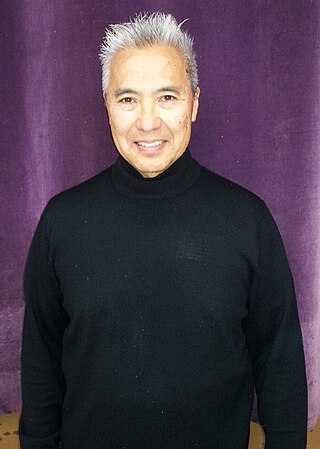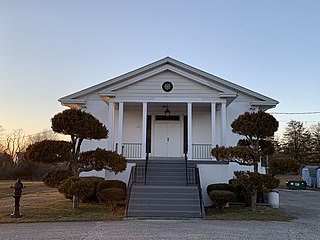
Taiko are a broad range of Japanese percussion instruments. In Japanese, the term taiko refers to any kind of drum, but outside Japan, it is used specifically to refer to any of the various Japanese drums called wadaiko and to the form of ensemble taiko drumming more specifically called kumi-daiko. The process of constructing taiko varies between manufacturers, and the preparation of both the drum body and skin can take several years depending on the method.

Ondekoza (鬼太鼓座), sometimes referred to as "Za Ondekoza", is a Japanese troupe specializing in taiko drumming.

Rick Shiomi is an internationally recognized, award-winning Japanese Canadian playwright, stage director, artistic director and taiko artist, and a major player in the Asian American/Canadian theatre movement. He is best known for his groundbreaking play Yellow Fever, which earned him the Bay Area Theater Circle Critics Award and “Bernie” Award. Over the last couple decades, Shiomi has also become a notable artistic and stage director. He directed the world premiere of the play Caught by Christopher Chen for which he received the Philadelphia Barrymore Award Nomination for Outstanding Direction. He is currently the Co-Artistic Director of Full Circle Theater Company.

Kenny Endo is an American musician and taiko master. He is the leader of several taiko ensembles and regularly tours, performing traditional and contemporary taiko music. Endo is also the first non-Japanese national to receive a natori in the field of hogaku hayashi, Japanese classical drumming. Today Endo composes his own music and plays taiko professionally as a solo artist, with his ensembles, and in collaboration with other artists.
Johnny Mori is a third-generation (Sansei) Japanese American musician and arts educator/administrator from Los Angeles. He was one of the seminal members of the taiko group Kinnara Taiko and the original taiko drummer for the Grammy nominated jazz-fusion band Hiroshima.

Roy Hirabayashi is a Japanese American composer, performer, teacher and activist known for his work as a leader in North American Taiko. He is co-founder of San Jose Taiko, the group's former Artistic and Executive Director, and was active in developing San Jose's Japantown and arts community.
Ryukyukoku Matsuri Daiko Hawaii (琉球國祭り太鼓ハワイ支部) is a chapter of the Okinawan Eisā taiko ensemble Ryukyukoku Matsuri Daiko. Often called RMD Hawaii for short, the chapter has branches on Oahu, Kauai, Maui and the Big Island of Hawaii in Kohala and Waimea. The headquarters for the Hawaii chapter is on Oahu.
The Midwest Buddhist Temple Ginza Holiday Festival is an annual Japanese cultural festival that occurs on the second weekend, Friday to Sunday, of August at 435 W. Menomonee Street in Chicago’s historic Old Town. The annual event has been since 1955, except for a three-year break from 2020 due to the COVID-19 pandemic. It will be held August 11–13, 2023.
Stanford Taiko is a collegiate taiko group based at Stanford University. One of the first collegiate taiko groups to form in North America, it was founded in the winter of 1992 by students Ann Ishimaru and Valerie Mih as a way to share taiko with the university community. As the founding organization of the Intercollegiate Taiko Invitational, Stanford Taiko has been instrumental in the development of collegiate taiko throughout the United States, as well as the larger North American taiko community through performing at the Taiko Jam of the North American Taiko Conference. Since 2000, the group has been active in the international scene through tours and exchange concerts in countries such as Japan, China, and Thailand.
Denver Taiko is the fourth taiko group founded in North America and the first taiko ensemble outside of California, United States. The group has a close partnership with the Tri-State Denver Buddhist Temple and performs throughout Colorado and neighboring states. In 2001, Denver Taiko received the Excellence in the Arts Award from Denver Mayor Wellington Webb. Today, Denver Taiko is an ensemble of third, fourth, and fifth generation Japanese Americans with a shared interest in honoring their Japanese American cultural heritage.
Jodaiko is a performing group based in University of California, Irvine that is specialized in taiko. Originally named "Tomo No Taiko", Jodaiko's origins lie in UCI's Japanese-American student group, Tomo No Kai ; it is often referred to as Tomo No Kai's sister group. Tomo No Taiko was founded in 1992 by Peggy Kamon and David Shiwota, both integral members in the Tomo No Kai community, in preparation for 1993 ‘’’Cultural Night’’’. Their influence on the group is reflected through the group's core values of bringing enjoyment of taiko--to both drummers and the audience alike--and spreading Japanese culture. Kamon, in charge of teaching interested Tomo No Kai members how to play taiko, also integrated core Buddhist values into Tomo No Taiko’s practices, performances, and policies. These Buddhist influences are also a result of Jodaiko's connection with Reverend Mas Kodani of Gardena Buddhist Church and Reverend George Matsubayashi of Venice Buddhist Church. Both provided the group with drums or their first performances in 1992, and continue to support their growth as a collegiate taiko group.
UCLA Kyodo Taiko is a collegiate taiko group specializing in taiko drumming. Founded in 1990, Kyodo is the first collegiate taiko group in the country. Kyodo is a Japanese term that means both "family" and "loud children." Many of Kyodo's members are not of Japanese descent.
Seattle Kokon Taiko is a North American taiko ensemble based in Seattle, Washington.
San Francisco Taiko Dojo, founded in 1968 by Grand Master Seiichi Tanaka, was the first taiko group in North America, and has been seen as the primary link between the Japanese and North American branches of the art form. Additionally, Tanaka's belief that learning to play taiko only requires a genuine interest in the art form, has greatly contributed to taiko's success and growth outside Japan.
Kinnara Taiko is a Japanese American drumming ensemble based out of Senshin Buddhist Temple in Los Angeles, US. They began playing taiko in 1969 when a few third-generation Japanese Americans gathered after an Obon festival and had an impromptu experimental session on an odaiko drum.
The Senshin Buddhist Temple is a Buddhist temple in Los Angeles, California. An affiliate of the Buddhist Churches of America (BCA), the temple was built in 1951. It is known for its maintenance of traditional practices and for cultivating one of the earliest taiko groups appearing in the United States under the leadership of Masao Kodani.
Osuwa Daiko (御諏訪太鼓) is a Japanese percussion group credited as the earliest groups to develop and perform the ensemble-style of taiko called kumi-daiko. Formed in Okaya, Japan in 1951 and founded by Daihachi Oguchi, Osuwa Daiko created a style of performance independent from performance during festivals, theatrical performance, and religious ceremonies, and transformed them into an ensemble performance. Contemporary taiko performance in Japan and in the rest of the world is widely based on the practices of Osuwa Daiko.

Oedo Sukeroku Taiko is a taiko group from Japan. It is considered the first taiko group to begin touring professionally and, sometimes, the first professional taiko group. The group formed in Tokyo in 1959, and is one of the oldest recognized taiko groups in Japan. Oedo Sukeroku Taiko has an eponymous style of performance, typically called Sukeroku style. They are also credited with popularizing taiko performance in North America.

The Seabrook Buddhist Temple is a Buddhist temple of the Jōdo Shinshū Hongwanji-ha sect in the Seabrook section of Upper Deerfield Township, New Jersey. It is an affiliate of the Buddhist Churches of America.
San Jose Taiko, founded in 1973, joined San Francisco Taiko Dojo and Kinnara Taiko as only the third Kumi-daiko, or ensemble taiko group, in North America. Initially a youth program at the San Jose Betsuin, a member of the Buddhist Churches of America, the group has evolved into a leading arts group not only in the Japanese American community but also in Asian American arts while maintaining unwaivering allegiance to Japantown, San Jose.







